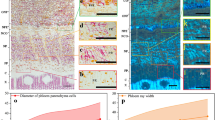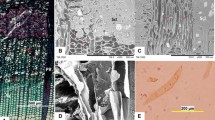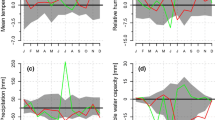Abstract
Main conclusion
Phloem production and structural development were interlinked with seasonal variation in the primary and secondary metabolites of phloem. Novel microtechniques provided new perspectives on understanding phloem structure and chemistry.
To gain new insights into phloem formation in Norway spruce (Picea abies), we monitored phloem cell production and seasonal variation in the primary and secondary metabolites of inner bark (non-structural carbohydrates and phenolic stilbene glucosides) during the 2012 growing season in southern and northern Finland. The structure of developing phloem was visualised in 3D by synchrotron X-ray microtomography. The chemical features of developing phloem tissues isolated by laser microdissection were analysed by chemical microanalysis. Within-year phloem formation was associated with seasonal changes in non-structural carbohydrates and phenolic extractive contents of inner bark. The onset of phloem cell production occurred in early and mid-May in southern and northern Finland, respectively. The maximal rate of phloem production and formation of a tangential band of axial phloem parenchyma occurred in mid-June, when total non-structural carbohydrates peaked (due to the high amount of starch). In contrast, soluble sugar content dropped during the most active growth period and increased in late summer and winter. The 3D visualisation showed that the new axial parenchyma clearly enlarged from June to August. Sub-cellular changes appeared to be associated with accumulation of stilbene glucosides and soluble sugars in the newest phloem. Stilbene glucosides also increased in inner bark during late summer and winter. Our findings may indicate that stilbene biosynthesis in older phloem predominantly occurs after the formation of the new band(s) of axial parenchyma. The complementary use of novel microtechniques provides new perspectives on the formation, structure, and chemistry of phloem.








Similar content being viewed by others
Abbreviations
- BH:
-
Breast height (1.3 m)
- CB:
-
Base of the living crown
- LMD:
-
Laser microdissection
- N1:
-
Site at Kivalo, in northern Finland
- NSC:
-
Non-structural carbohydrates (defined here as soluble sugars + starch)
- S1:
-
Site 1, Haapastensyrjä, in southern Finland
- S2:
-
Site 2, Ruotsinkylä, in southern Finland
- µCT:
-
Synchrotron X-ray microtomography
References
Alfieri FJ, Evert RF (1968) Seasonal development of the secondary phloem in Pinus. Am J Bot 55:518–528
Antonova GF, Stasova VV (2006) Seasonal development of phloem in scots pine stems. Ontogenez 37:368–382
Antonova GF, Stasova VV (2008) Seasonal development of phloem in Siberian larch stems. Russ J Dev Biol 39:207–218
Baek K-H, Skinner DZ (2012) Production of reactive oxygen species by freezing stress and the protective roles of antioxidant enzymes in plants. J Agric Chem Environ 1:34–40
Begum S, Nakaba S, Oribe Y, Kubo T, Funada R (2010) Changes in the localization and levels of starch and lipids in cambium and phloem during cambial reactivation by artificial heating of main stems of Cryptomeria japonica trees. Ann Bot 106:885–895
Begum S, Nakaba S, Yamagishi Y, Oribe Y, Funada R (2013) Regulation of cambial activity in relation to environmental conditions: understanding the role of temperature in wood formation of trees. Physiol Plant 147:46–54
Brodersen CR (2013) Visualizing wood anatomy in three dimensions with high-resolution X-ray microtomography (MCT)—a review. IAWA J 34:408–424
Chong J, Poutaraud J, Hugueney P (2009) Metabolism and roles of stilbenes in plants. Plant Sci 177:143–155
Cochard H, Delzon S, Badel E (2015) X-ray microtomography (micro-CT): a reference technology for high-resolution quantification of xylem embolism in trees. Plant Cell Environ 38:201–206
Deslauriers A, Giovannelli A, Rossi S, Castro G, Fragnelli G, Traversi L (2009) Intra-annual cambial activity and carbon availability in stem of poplar. Tree Physiol 29:1223–1235
Deslauriers A, Beaulieu M, Balducci L, Giovannelli A, Gagnon MJ, Rossi S (2014) Impact of warming and drought on carbon balance related to wood formation in black spruce. Ann Bot 114:335–345
Evert RF (2006) Esau’s plant anatomy. Meristems, cells, and tissues of the plant body: their structure, function, and development. Wiley, Hoboken
Franceschi V, Krekling T, Berryman A, Christiansen E (1998) Specialized phloem parenchyma cells in Norway spruce (Pinaceae) bark are an important site of defense reactions. Am J Bot 85:601–615
Franceschi VR, Krokene P, Krekling T, Christiansen E (2000) Phloem parenchyma cells are involved in local and distant defense responses to fungal inoculation or bark-beetle attack in Norway spruce (Pinaceae). Am J Bot 87:314–326
Franceschi VR, Krokene P, Christiansen E, Krekling T (2005) Anatomical and chemical defenses of conifer bark against bark beetles and other pests. New Phytol 167:353–375
Froelich DR, Mullendore DL, Jensen KH, Ross-Elliott TJ, Anstead JA, Thompson GA, Pélissier HC, Knoblauch M (2011) Phloem ultrastructure and pressure flow: sieve-element-occlusion-related agglomerations do not affect translocation. Plant Cell 23:4428–4445
Giovannelli A, Emiliani G, Traversi ML, Deslauriers A, Rossi S (2011) Sampling cambial region and mature xylem for non structural carbohydrates and starch analyses. Dendrochronologia 29:177–182
Gričar J, Čufar K (2008) Seasonal dynamics of phloem and xylem formation in silver fir and Norway spruce as affected by drought. Russ J Plant Physiol 55:538–543
Gričar J, Prislan P, Gryc V, Vavrčík H, de Luis M, Čufar K (2014) Plastic and locally adapted phenology in cambial seasonality and production of xylem and phloem cells in Picea abies from temperate environments. Tree Physiol 34:869–881. doi:10.1093/treephys/tpu026
Gruber A, Pirkebner D, Oberhuber W (2013) Seasonal dynamics of mobile carbohydrate pools in phloem and xylem of two alpine timberline conifers. Tree Physiol 33:1076–1083
Hammerbacher A, Ralph SG, Bohlmann J, Fenning TM, Gershenzon J, Schmidt A (2011) Biosynthesis of the major tetrahydroxystilbenes in spruce, astringin and isorhapontin, proceeds via resveratrol and is enhanced by fungal infection. Plant Physiol 157:876–890
Henttonen HM, Mäkinen H, Nöjd P (2009) Seasonal dynamics of the radial increment of Scots pine and Norway spruce in the southern and middle boreal zones in Finland. Can J For Res 39:606–618
Herms DA, Mattson WJ (1992) The dilemma of plants: to grow or defend. Quart Rev Biol 67:283–335
Hoch G, Popp M, Korner C (2002) Altitudinal increase of mobile carbon pools in Pinus cembra suggests sink limitation of growth at the Swiss treeline. Oikos 98:361–374
Jyske T, Hölttä T (2015) Comparison of phloem and xylem hydraulic architecture in Picea abies stems. New Phytol 205:102–115
Jyske T, Mäkinen H, Kalliokoski T, Nöjd P (2014a) Intra-annual tracheid production of Norway spruce and Scots pine across a latitudinal gradient in Finland. Agr For Meteorol 194:241–254
Jyske T, Laakso T, Latva-Mäenpää H, Tapanila T, Saranpää P (2014b) Yield of stilbene glucosides from the bark of young and old Norway spruce stems. Biomass Bioenergy 71:216–227
Kendall EJ, McKersie BD (1989) Free radical and freezing injury to cell membranes of winter wheat. Physiol Plant 76:86–94
Kozlowski TT (1992) Carbohydrate sources and sinks in woody plants. Bot Rev 58:107–222
Krekling T, Franceschi VR, Berryman AA, Christiansen E (2000) The structure and development of polyphenolic parenchyma cells in Norway spruce (Picea abies) bark. Flora 195:354–369
Krogell J, Holmbom B, Pranovich A, Hemming J, Willför S (2012) Extraction and chemical characterization of Norway spruce inner and outer bark. Nord Pulp Pap Res J 27:6–17
Krokene P, Nagy NE, Solheim H (2008) Methyl jasmonate and oxalic acid treatment of Norway spruce: anatomically based defense responses and increased resistance against fungal infection. Tree Physiol 28:29–35
Larson PR (1994) The vascular cambium: development and structure. Springer, Berlin
Latva-Mäaenpää H, Laakso T, Sarjala T, Wähälä K, Saranpää P (2014) Root neck of Norway spruce as a source of bioactive lignans and stilbenes. Holzforschung 68:1–7
Latva-Mäenpää H, Laakso T, Sarjala T, Wähälä K, Saranpää P (2013) Variation of stilbene glucosides in bark extracts obtained from roots and stumps of Norway spruce (Picea abies [L.] Karst.). Trees 27:131–139
Leroux O, Leroux F, Bellefroid E, Claeys M, Couvreur M, Borgonie G, Van Hoorebeke L, Masschaele B, Viane R (2009) A new preparation method to study fresh plant structures with X-ray computed tomography. J Microsc 233:1–4
Li SH, Nagy NE, Hammerbacher A, Krokene P, Niu XU, Gershenzon J et al (2012) Localization of phenolics in phloem parenchyma cells of Norway spruce (Picea abies). Chem Bio Chem 13:2707–2713
Liu J-L, Miao Y-C, Zhang K-W (2011) Sequestration and transport of lignin monomeric precursors. Molecules 16:710–727
Mäkinen H, Nöjd P, Saranpää P (2003) Seasonal changes in stem radius and production of new tracheids in Norway spruce. Tree Physiol 23:959–968
Manach C, Scalbert A, Morand C, Rémésy C, Jiménez L (2004) Polyphenols: food sources and bioavailability. Am J Clin Nutr 79:727–747
Martínez-Vilalta J (2014) Carbon storage in trees: pathogens have their say. Tree Physiol 34:215–217. doi:10.1093/treephys/tpu010
Massad T, Trumbore SE, Ganbat G, Reichelt M, Unsicker S, Boeckler A, Gleixner G, Gershenzon J, Ruehlow S (2014) An optimal defense strategy for phenolic glycoside production in Populus trichocarpa – isotope labeling demonstrates secondary metabolite production in growing leaves. New Phytol 203:607–619. doi:10.1111/nph.12811
McDowell NG, Pockman W, Allen C et al (2008) Mechanisms of plant survival and mortality during drought: why do some plants survive while others succumb? New Phytol 178:719–739
Nagy NE, Franceschi VR, Solheim H, Krekling T, Christiansen E (2000) Wound-induced traumatic resin duct development in stems of Norway spruce (Pinaceae): anatomy and cytochemical traits. Am J Bot 87:302–313
Nishizawa A, Yabuta Y, Shigeoka S (2008) Galactinol and raffinose constitute a novel function to protect plants from oxidative damage. Plant Physiol 147:1251–1263
Oribe Y, Funada R, Kubo T (2003) Relationships between cambial activity, cell differentiation and the localization of starch in storage tissues around the cambium in locally heated stems of Abies sachalinensis (Schmidt) Masters. Trees 17:185–192
Prislan P, Gričar J, de Luis M, Smith KT, Čufar K (2013) Phenological variation in xylem and phloem formation in Fagus sylvatica from two contrasting sites. Agric For Meteorol 180:142–151
Robb EL, Stuart JA (2014) The stilbenes resveratrol, pterostilbene and piceid affect growth and stress resistance in mammalian cells via a mechanism requiring estrogen receptor beta and the induction of Mn-superoxide dismutase. Phytochemistry 98:164–173
Rossi S, Deslauriers A, Morin H (2003) Application of the Gompertz equation for the study of xylem cell development. Dendrochronologia 21:33–39
Rossi S, Anfodillo T, Menardi R (2006a) Trephor: a new tool for sampling microcores from tree stems. IAWA J 27:89–97
Rossi S, Deslauriers A, Anfodillo T, Morin H, Saracino A, Motta R, Borghetti M (2006b) Conifers in cold environments synchronize maximum growth rate of tree-ring formation with day length. New Phytol 170:301–310
Rossi M, Caruso F, Antonioletti R, Viglianti A, Traversi G, Leone S, Basso E, Cozzi R (2013) Scavenging of hydroxyl radical by resveratrol and related natural stilbenes after hydrogen peroxide attack on DNA. Chem Biol Interact 206:175–185
Ryan MG, Asao S (2014) Phloem transport in trees. Tree Physiol 34:1–4
Sala A, Woodruff DR, Meinzer FC (2012) Carbon dynamics in trees: feast or famine? Tree Physiol 32:764–775
Sevanto S, McDowell NG, Dickman LT, Pangle R, Pockman WT (2014) How do trees die? A test of the hydraulic failure and carbon starvation hypotheses. Plant, Cell Environ 37:153–161
Simard S, Giovannelli A, Treydte K, Traversi ML, King GM, Frank D, Fonti P (2013) Intra-annual dynamics of non-structural carbohydrates in the cambium of mature conifer trees reflects radial growth demands. Tree Physiol 33:913–923
Solhaug K (1990) Stilbene glucosides in bark and needles from Picea species. Scand J For Res 5:59–67
Spicer R (2014) Symplasmic networks in secondary vascular tissues: parenchyma distribution and activity supporting long-distance transport. J Exp Bot 65:1829–1848
Sundberg B, Ericsson A, Little CHA, Nasholm T, Gref R (1993) The relationship between crown size and ring width in Pinus sylvestris L. stems: dependence on indole-3-acetic acid, carbohydrates and nitrogen in the cambial region. Tree Physiol 12:347–362
Sundberg A, Sundberg K, Lillandt C, Holmbom B (1996) Determination of hemicelluloses and pectins in wood and pulp fibres by acid methanolysis and gas chromatography. Nord Pulp Paper Res J 11(216–219):226
Toscano Underwood CD, Pearce RB (1991a) Astringin and isorhapontin distribution in Sitka spruce trees. Phytochemistry 30:2183–2218
Toscano Underwood CD, Pearce RB (1991b) Variation in the levels of the antifungal stilbene glucosides astringin and isorhapontin in the bark of Sitka spruce (Picea sitchensis (Bong.) Carr.). Eur J For Pathol 21:279–289
Trockenbrodt M (1990) Survey and discussion of the terminology used in bark anatomy. IAWA Bull 11:141–166
Truernit E (2014) Phloem imaging. J Exp Bot 65:1681–1688
Tsuyama T, Kawai R, Shitan N, Matoh T, Sugiyama J, Yoshinaga A, Takabe K, Fujita M, Yazaki K (2013) Proton-dependent coniferin transport, a common major transport event in differentiating xylem tissue of woody plants. Plant Physiol 162:918–926
van Bel AJE (1990) Xylem-phloem exchange via the rays: the undervalued route of transport. J Exp Bot 41:631–644
van Bel AJE (2003) The phloem, a miracle of ingenuity. Plant, Cell Environ 26:125–149
Whetten RW, MacKay JJ, Sederoff RR (1998) Recent advances in understanding lignin biosynthesis. Annu Rev Plant Physiol Plant Mol Biol 49:585–609
Witzell J, Martin J (2008) Phenolic metabolites ion the resistance of northern forest trees to pathogens e past experiences and future prospects. Can J For Res 38:2711–2727
Woodward S, Pearce RB (1988) The role of stilbenes in resistance of Sitka spruce (Picea sitchensis (Bong) Carr.) to entry of fungal pathogens. Physiol Mol Plant Pathol 33:127–149
Zeide B (1993) Analysis of growth equations. For Sci 39:594–616
Acknowledgments
We thank the staff of the Finnish Forest Research Institute, and several students and trainees, for assisting in field and laboratory work. We also thank Dr. P. Saranpää, Dr. H. Mäkinen, and Prof. B. Holmbom for their help designing of the study. We are grateful to the Electron Microscopy Unit of the Institute of Biotechnology, University of Helsinki, for providing laboratory facilities and help in sample preparation. We acknowledge the European Synchrotron Radiation Facility (ESRF) for providing beam time for the µCT measurements, and are grateful for P. Tafforeau and C. Soriano for their help in using beamline ID19. P. Ahvenainen, A. Kallonen, A. Meaney, and K. Pirkkalainen of the Department of Physics, University of Helsinki, provided valuable assistance in carrying out the µCT experiments. Prof. R. Serimaa is acknowledged for her help designing the study and participating in the µCT experiment. This study was carried out under the framework of the COST FP1106 network STReESS and funded by the post-doctoral research grant from the Academy of Finland (no. 250299). This work was also supported by JSPS KAKENHI Grant No. 26-04395 and JSPS post-doctoral Grant No. P14395.
Author information
Authors and Affiliations
Corresponding author
Additional information
Special topic: Polyphenols: biosynthesis and function in plants and ecosystems. Guest editor: Stefan Martens.
Electronic supplementary material
Below is the link to the electronic supplementary material.
425_2015_2347_MOESM1_ESM.docx
Structural development of Norway spruce phloem during the growing season 2012 in northern Finland (Kivalo-KI) as visualised in 3D by synchrotron phase-contrast microtomography. The samples from June (a,b), July (c), and early September (d) at breast height (BH). The large starch granules are visible in axial parenchyma cell (b) segmented from June sample. X, xylem; C, cambium; CY, current-year phloem; PY, previous-year phloem; CP, collapsed phloem. Scale bars (in radial direction in µm): 464 (a), 202 (b), 249 (c) (DOCX 3067 kb)
425_2015_2347_MOESM2_ESM.docx
In orange/red, a 3D rendering of the cellular contents of Norway spruce axial parenchyma (August 2012, Haapastensyrjä, CB sample) showing typical short cells, and a sieve cell-like cell (separated in inlet) with cellular contents (DOCX 973 kb)
Rights and permissions
About this article
Cite this article
Jyske, T.M., Suuronen, JP., Pranovich, A.V. et al. Seasonal variation in formation, structure, and chemical properties of phloem in Picea abies as studied by novel microtechniques. Planta 242, 613–629 (2015). https://doi.org/10.1007/s00425-015-2347-8
Received:
Accepted:
Published:
Issue Date:
DOI: https://doi.org/10.1007/s00425-015-2347-8




